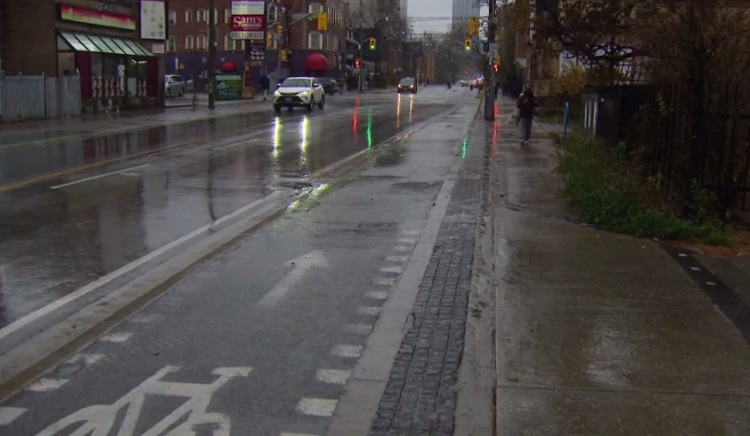A disability advocate is speaking out about a bike lane installed along Eglinton Avenue that he says could be dangerous for visually impaired pedestrians. In a video released by the Accessibility for Ontarians with Disabilities Act Alliance (AODA), David Lepofsky, AODA’s chair, walks along the north side of Eglinton with his cane, unable to tell the difference between the sidewalk and the raised bike lane. Lepofsky, a lawyer and associate professor, said he had to be told that the bike lane was at sidewalk level, not road level.
“I’d never encountered this before. It is a serious and dangerous threat to blind pedestrians like me,” Leposky told CityNews. And he’s not just concerned for himself and other visually impaired pedestrians.
“It’s also a danger to sighted pedestrians if they’re looking down at their phone, texting and having to walk into a bike path,” explained Lepofsky. “It’s dangerous to cyclists because I could be walking near the bike path without knowing I’m there. I might veer toward it, accidentally sticking my foot in the spokes of a rider who’s racing along.
This could damage the bike and possibly send the cyclist flying. ” The City of Toronto had installed dark, granite tactile pavers, but he disagrees that they distinguish the bike path. “I have been using a white cane and walking independently as a blind person for 40 years.
I think I’ve had enough time to know when there’s proper guidance on the sidewalk,” said Lepofsky. “What they installed is not. It may be visually obvious to a sighted person, but using a cane does not tell me that there’s a bike path there.
” Becky Katz, the City of Toronto’s manager of cycling and pedestrian products, said accessibility testing with people with low to no vision was completed on the street. “It is a standard that complies with our accessibility regulations. ” It has also been utilized on Sherbourne Street and other locations, but Katz added they take this type of feedback very seriously.
“We have done a number of tests with the same tactile, and so we’ll definitely be looking to ensure that they’re installed correctly and that they do comply with the city standard for sidewalk-level bikeways and adjacent to the sidewalk. ” Katz says the design standard was developed long ago and is not a reactive standard. However, Lepofsky says that even if a marker distinguished which side was a safe sidewalk and which side was a bike path, it would be hard for the visually impaired to determine which side was which.
Lepofsky said the only solution is to lower the bike path to road level. “We want a clear, immediate decision that there will never be another bike path built at sidewalk level. ” When asked if the bike lane could be changed, Katz said, “It’s important to note that the LRT and the streetscape construction is not complete.
But, absolutely, our street designs always evolve. Many streets within the city have evolved over time, along with our design standards. ” With files from Mark McAllister.
From: toronto_citynews
URL: https://toronto.citynews.ca/2023/11/21/disability-advocate-eglinton-avenue-bike-lane-danger-visually-impaired-pedestrians/
